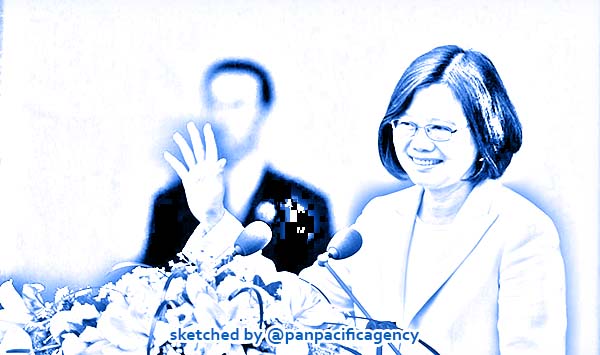[Analytics] Taiwan’s 2020 election isn’t just about the President

Taiwan President Tsai Ing-wen waves to the crowd on May 20, 2016 in Taipei, Taiwan. Sketched by the Pan Pacific Agency.
If Taiwan’s election were tomorrow, Tsai Ing-wen of the Democratic Progressive Party (DPP) would likely win. Recent polls show she is ahead of Kuomintang (KMT) candidate Han Kuo-yu by over 12 per cent. But it is far too early to assume the race is over — there is still over two months before the election, a lifetime in Taiwanese politics. Lev Nachman specially for the East Asia Forum.
Although the majority of international press coverage has focused on Tsai and Han, there is another part of this election that is just as important: the fight for Taiwan’ s legislature. This fight for Taiwan’s Legislative Yuan (LY) is just as contentious as the presidential race, if not more so. Even if the DPP wins the presidency, it will be stalled for four years if it loses the LY to the KMT.
Taiwan uses a mixed system of first-past-the-post presidential and district candidate elections and proportional representation (PR) party votes. Citizens vote for their president, district representative and the party they wish to support. Since the presidential and district candidate elections are first-past-the-post, there are usually only two candidates running against each other.
The PR vote allow citizens to express their support for a party regardless of who is running in their local district or who is the president. If a party receives the 5 per cent threshold, it qualifies for PR seats in parliament. The LY has 113 seats: 73 district election seats, 6 seats reserved for indigenous Taiwanese and 34 seats reserved for PR.
Although the KMT’s presidential candidate is currently behind in the polls, the party remains in a strong position to take back the LY. The DPP currently controls the LY, but many of the seats won in 2016 were won under unique conditions and will be difficult to retain.
In 2016, support for the KMT was at an all-time low after the anti-KMT 2014 Sunflower Movement. Even KMT supporters were jaded with the party when it swapped presidential candidates months before the election, from the wildly unpopular Hung Hsiu-chu to the slightly less unpopular Eric Chu.
The Sunflower Movement also gave rise to Taiwan’s ‘Third Force’ parties like the New Power Party (NPP). These new activist-based parties, along with the DPP, took advantage of widely felt anti-KMT sentiment to win a number of district seats that normally go to the KMT.
The situation will be radically different in 2020. Although Han is not polling well, the wave of anti-KMT sentiment rooted in the Sunflower Movement has died down. General support for the party is not nearly as bleak as it was four years ago. The midterms in November 2018 were devastating for the DPP and signalled that the party needs to drastically change its strategy in order to maintain its position as the ruling party in 2020.
Many of the close races the DPP won in 2016 will likely not be won again in 2020. Although Tsai is clearly ahead in the polls, one recent survey that looked at preferences in the PR vote sees the KMT at 34.5 per cent and the DPP at 25.4 per cent. This indicates that at least for the LY elections the KMT is not in the same weak position it was four years ago.
Two other parties besides the KMT and DPP are worth paying attention to in 2020. The NPP, a party founded by Sunflower Movement activists, became the third most represented party in the LY in 2016. Four years ago, there was a great deal of excitement about this party’s potential to grow and become a properly institutionalised third party. In 2016, they won three district elections and earned just under 7 per cent of the PR vote giving them two additional seats in the LY.
But four years later the party has struggled to grow and maintain its position. One key issue within the NPP is whether or not to work cooperatively with the DPP again, or to ‘walk their own path’ regardless of the DPP’s candidacy decisions. Supporters from 2016 are not likely to show up in such large numbers for Third Force parties as they have in previous elections. The last year has been rough for the young party due to internal disagreements and factionalisation, which led to famous rock star politician Freddy Lim leaving the very party he helped found.
The biggest challenge to the NPP is the newly formed Taiwan People’s Party (TPP). Founded by Taipei Mayor Ko Wen-je, the TPP has effectively caused a split within the ‘anti-establishment’ vote. Although many see the TPP and NPP as part of the same ‘Third Force’, these two parties are drastically different.
The NPP is an outspoken pro-independence party founded out of a mass anti-KMT social movement. Its stance is more anti-KMT than anti-establishment. Its contention with the DPP is not because of a hatred of big parties, but rather their self-described goal of ‘monitoring’ the DPP.
Ko’s TPP has no political stance on independence or unification, leaving many to wonder what exactly his party does stand for. Ko has tried to play middleman with China, only to repeatedly blunder and reveal pro-China leanings. Ko’s party is unlikely to perform well this election, but given recent PR polls his party may get enough party votes to secure some seats in the LY.
Tsai may win this upcoming presidential election, but her ability to push policy will be severely limited if the DPP loses the LY. Contention among smaller parties who previously worked with the DPP will further hinder Tsai’s odds of a successful second term. In the face of this power split among parties, Taiwanese politics is undoubtedly facing a hard four years.
Lev Nachman is a PhD candidate in political science at the University of California, Irvine.